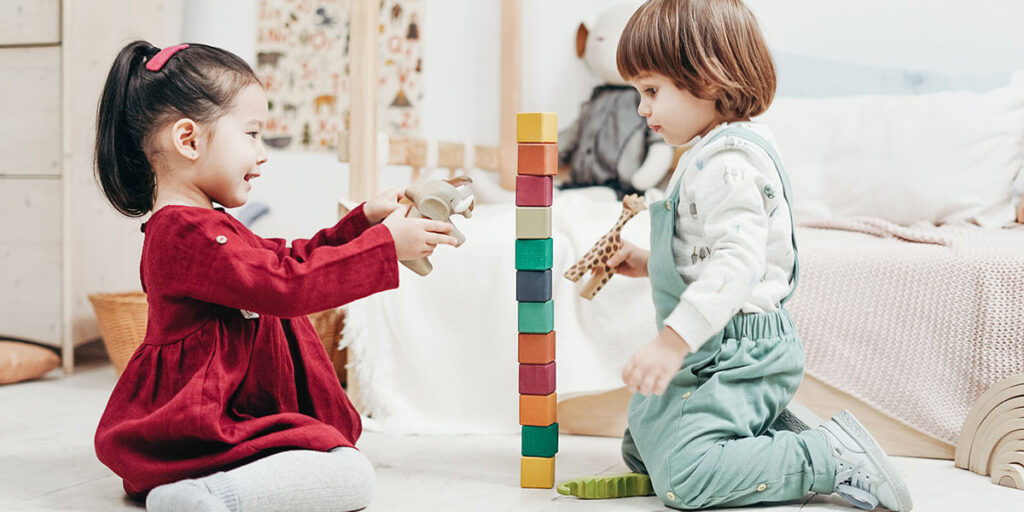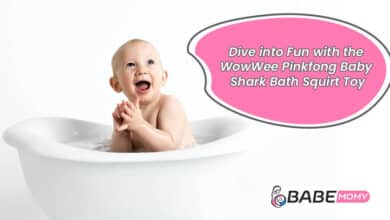
Introduction
Wooden baby toys have an intrinsic allure that transcends time. They provide a classic and timeless charm that captivates both parents and children. Beyond their enchanting appeal, these toys are crucial in supporting a child’s growth and development. Age-appropriate toys are essential for nurturing various aspects of a child’s development, from sensory exploration to cognitive abilities.
Benefits of Wooden Baby Toys
Wooden baby toys offer many benefits that set them apart from their plastic counterparts. Let’s take a look at some of the most popular varieties.
Durability and Sustainability
Wooden baby toys are renowned for their durability. Crafted from sturdy materials, they can withstand the test of time and endure even the most enthusiastic play sessions. With their sustainability in mind, these toys are often made from responsibly sourced wood, ensuring an eco-friendly choice for conscious parents.
Sensory Exploration and Stimulation
Wooden toys provide an opportunity for sensory exploration and stimulation. Their natural textures, weight, and temperature variations offer a tactile experience that engages a child’s senses. From smoothness to grain patterns, wooden toys offer a sensory-rich play experience that enhances a child’s understanding of the world.
Enhancing Fine Motor Skills
The intricacy and design of wooden baby toys make them ideal for developing fine motor skills. Activities such as grasping, stacking, and manipulating different parts of the toys aid in refining a child’s hand-eye coordination and dexterity. As they manipulate the pieces, children gain control over their movements, enhancing their fine motor skills.
Encouraging Imaginative Play
Wooden baby toys stimulate imaginative play, allowing children to explore their creativity and expand their horizons. These toys provide an open canvas for storytelling, role-playing, and building make-believe worlds. As children engage in imaginative play, they develop their narrative skills, problem-solving abilities, and emotional awareness.
Developing Cognitive Abilities
Wooden baby toys offer a pathway to developing cognitive abilities at an early age. Through playing with these toys, children learn to categorize, and compare shapes and colors, and develop spatial awareness. This cognitive engagement lays a strong foundation for future learning and critical thinking.

Different Types of Wooden Toys
Wooden toys encompass a wide range of choices that cater to various developmental aspects. Let’s explore some of the most popular types:
Classic Stacking and Nesting Toys
Stacking and nesting toys are fundamental baby toys that foster motor skills and color recognition. The act of stacking allows children to refine their hand-eye coordination and learn about balance and stability. Additionally, these toys’ vibrant colors and unique shapes engage children in recognizing and differentiating between colors and shapes.
Manipulative Toys
Manipulative toys such as puzzles and shape sorters introduce children to problem-solving and cause-and-effect learning. Puzzles challenge children to think critically, analyze shapes, and find the correct fit. Shape sorters enhance cognitive abilities by requiring children to match shapes and understand spatial relationships. The concept of object permanence is also introduced through these toys, aiding in a child’s cognitive growth.
Pull and Push Toys
Pull and push toys offer an avenue for developing coordination and balance. These toys require children to use their gross motor skills to move the toy while maintaining stability. By engaging in active play with pull and push toys, children enhance their coordination, balance, and spatial awareness.
Considerations when Choosing Baby Toys
When choosing the toys, several factors warrant attention. These considerations ensure the safety, suitability, and longevity of the toys:
Safety Standards and Certifications
Safety should be the paramount concern when selecting wooden baby toys. Look for toys with non-toxic finishes to ensure they are safe for children to interact with. Additionally, ensure that the toys comply with established safety regulations such as ASTM and EN standards.
Age Appropriateness and Developmental Stages
Selecting wooden baby toys that match a child’s developmental stage is of utmost importance. Different toys cater to various age ranges, with features that suit specific developmental milestones. Understanding a child’s capabilities and selecting toys accordingly promotes optimal growth and engagement.
Size, Weight, and Ease of Grasping
Consider the size, weight, and grip of the wooden baby toys. Toys that are easy to grasp help children develop their fine motor skills and provide a comfortable play experience. Larger toys may be suitable for older children, while lighter toys accommodate younger ones.
Multi-functional Toys for Extended Use
Opt for multi-functional wooden baby toys that offer versatility and extended use. These toys can adapt to a child’s changing interests and developmental stages, providing a longer lifespan and value for money.
Caring for Wooden Baby Toys
Proper care and maintenance of toys ensure their longevity and safety. Consider the following tips:
Cleaning and Maintenance Tips
To clean wooden baby toys, use a soft cloth dampened with mild soap and water. Avoid excessive moisture that may damage the wood. Ensure the toys are thoroughly dry before storing them. Regularly inspect the toys for any signs of wear or damage, addressing them promptly to maintain safety.
Storage Guidelines for Longevity
Proper storage is essential for preserving wooden baby toys. Keep them in a clean, dry area away from direct sunlight and extreme heat or cold. Consider using storage bins or shelves to organize the toys and prevent them from getting damaged or lost.
Repairing Common Wear and Tear
Over time, wooden toys may encounter wear and tear. Thankfully, many minor damages can be repaired with a little effort. Repair loose parts, smoothen rough edges, and maintain the structural integrity of the toys. Regularly check for loose screws or nails and ensure that the toys remain safe for play.
Popular Brands and Artisans
Several renowned companies specialize in creating baby toys. These brands offer various options, combining craftsmanship and quality materials. Additionally, independent artisans bring their unique creations to the market, providing a personalized touch to wooden toys. Exploring online marketplaces is a great way to discover the diverse range of wooden baby toys available.
Wooden vs. Plastic Baby Toys
When comparing wooden and plastic baby toys, several factors come into play:
Environmental Impact and Sustainability
Wooden toys are often the more sustainable choice, as they are crafted from renewable resources and contribute to reducing plastic waste. By opting for wooden toys, parents can make a positive impact on the environment.
Safety Concerns of Plastic Toys

Plastic toys may raise safety concerns, especially if they contain harmful chemicals such as phthalates or lead. Wooden toys, on the other hand, are generally considered safer options, particularly when they adhere to strict safety standards.
Role of Sensory Experience in Wooden Toys
Wooden toys offer a sensory-rich experience. The natural textures, scents, and weight of these toys engage a child’s senses, providing a more enriching and tactile play experience compared to many plastic toys.
Empowering Independence through Wooden Baby Toys
Wooden baby toys empower children to develop essential skills and foster independence. Below are several methods they employ to accomplish this.
Promoting Self-Regulation and Problem-Solving Skills
By engaging with wooden toys, children learn to regulate their emotions, think critically, and solve problems independently. These toys provide opportunities for children to face challenges, make decisions, and overcome obstacles, building their problem-solving abilities.
Fostering Creativity and Open-Ended Play
Wooden baby toys facilitate open-ended play, encouraging children to use their imagination and explore their creativity. With simple designs and minimal constraints, these toys allow children to take the reins of their playtime, fostering a sense of autonomy and creativity.
Reducing Screen Time Dependency
In a world dominated by screens, wooden baby toys offer an alternative that promotes active engagement and reduces dependency on technology. By providing captivating, tangible, and interactive play experiences, wooden toys offer a healthy balance and encourage children to disconnect from screens and engage with their surroundings.
Integrating Wooden Toys into Everyday Life
Incorporating wooden toys into a child’s daily routine opens up opportunities for enriched play experiences. Consider the following suggestions:
Incorporating Toys into Daily Routines
Integrate wooden toys into daily routines, such as during bath time or mealtime. Water-resistant wooden toys can make bath time more interactive and enjoyable. Additionally, using wooden toys during mealtime can engage children and stimulate the experience.
Creating Montessori-Inspired Play Environments
Inspired by Montessori principles, create play environments that are organized, aesthetically pleasing, and conducive to independent exploration. Display wooden toys on low shelves within a child’s reach, promoting autonomy and ease of selection.
Co-Play and Parent-Child Bonding Opportunities
Wooden baby toys provide an avenue for co-play, fostering parent-child bonding and connection. Engage in play with your child, let your imagination run wild, and create lasting memories together. You can enhance their learning experiences and strengthen your bond by actively participating in their playtime.
Research and Expert Opinions on Baby Toys
Scientific studies and expert opinions support the benefits of wooden toys. Research indicates that these toys contribute to cognitive development, motor skills, and problem-solving abilities. Child development experts recognize the value of wooden toys in nurturing crucial skills and creativity. Additionally, testimonials and reviews from parents highlight the positive impact baby toys have had on their children’s growth.
Budget-Friendly Options and DIY Possibilities
Affordable wooden toy alternatives exist for those on a budget. With a bit of creativity, repurposing household items can also result in unique and resourceful toys. However, it is important to exercise caution and ensure that all DIY toys adhere to safety regulations.
Transitioning from Baby Toys to Toddler Toys
As children grow and develop, their toy needs evolve. Gradually introduce more complex playthings that challenge their expanding skills and curiosity. Wooden toys provide longevity and adaptability, making them ideal for supporting a child’s development through various stages.
Best Practices for Playtime with Wooden Toys
Optimize playtime with baby toys by following these best practices:
Supervision and Age-Appropriate Instructions
Supervise children during playtime and provide age-appropriate instructions to ensure their safety. Set boundaries and guidelines to create a safe and engaging play environment.
Promoting Exploration and Open-ended Play
Encourage children to explore and create their narratives with wooden toys. Allow them to initiate and lead the play, fostering independence, creativity, and problem-solving.
Recognizing and Encouraging Milestones
Observe a child’s milestones as they interact with wooden toys. Celebrate their achievements and provide positive reinforcement. Encouragement and praise for their progress fuels their motivation and self-confidence.
Summary: A Timeless Investment in Childhood
Wooden baby toys hold a special place in childhood memories and offer lasting value. From their aesthetic appeal and developmental benefits to their eco-friendly nature, wooden toys stand the test of time. Embrace the charm and versatility of wooden toys, making informed choices that support a child’s growth and allow them to create cherished memories.
FAQs: Answering Common Queries
Addressing common queries about wooden baby toys:
Can wooden baby toys be safely washed?
Yes, wooden toys can be safely washed. Use a soft cloth dampened with mild soap and water to clean the toys. Ensure they are thoroughly dry before allowing children to play with them to avoid moisture damage.
How long can wooden baby toys last?
With proper care, wooden baby toys can last for many years. High-quality wooden toys are durable and can withstand extensive play. Regular maintenance and addressing any wear and tear promptly contribute to their longevity.
What age range do wooden baby toys typically cater to?
Wooden baby toys cater to a broad age range, typically from infancy to toddlerhood. Different toys within this category target specific developmental milestones, ensuring suitability for each stage.
Are there any potential hazards associated with wooden toys?
While baby toys are generally safe, some hazards to watch out for include loose parts, splinters, and rough edges. Regular inspection and prompt repairs address these risks and ensure the safety of the toys.


